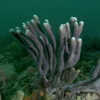General Description
An orange sponge species with encrusting form. Size of about 10 cm.
Biology
Species within this genus group often settle on the shells of bivalve molluscs, or are cut off by decorator crabs and worn on the crab's carapace. In both cases the host animals gain camouflage and chemical protection, while the sponge obtains mobility and may gain better access to food-rich waters.
Habitat
Shell areas, to depth of 30 m.
Sponge gardens
Distribution guide
Victoria.
Species Group
Depth
Water Column
Max Size
10 cm
Diet
Plankton or particles
Commercial Species
No
Global Dispersal
Recorded in Australia
Identify
Conservation Status
- DSE Advisory List : Not listed
- EPBC Act 1999 : Not listed
- IUCN Red List : Not listed






